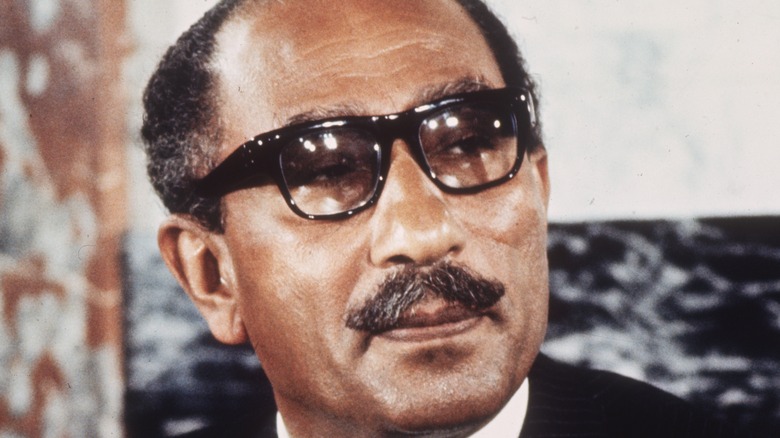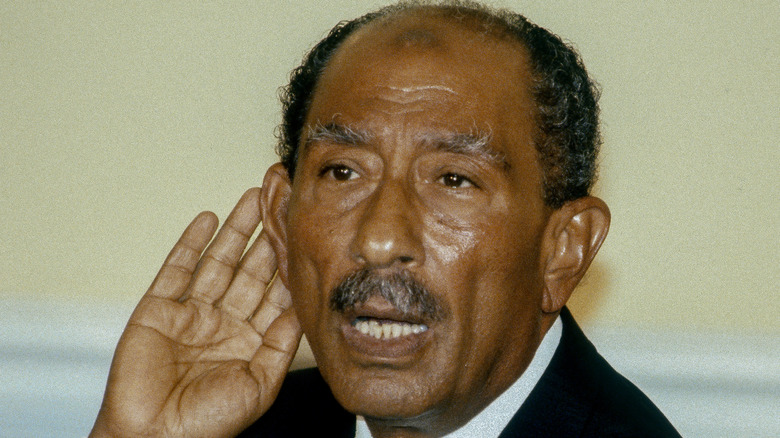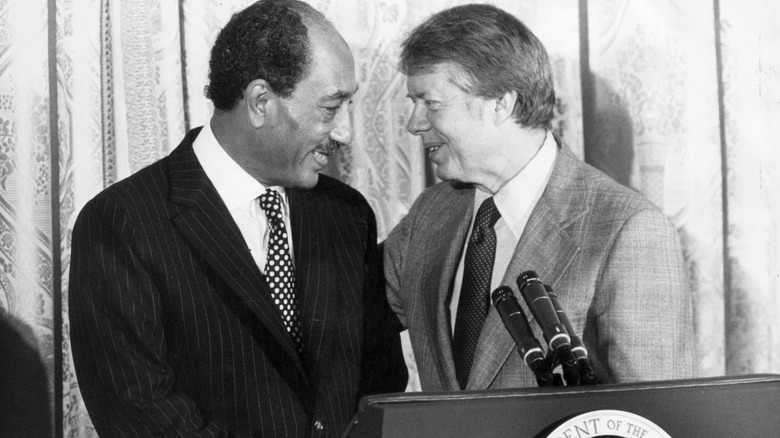The Truth About Egyptian President Anwar Sadat's Assassination
Egypt's third president was Anwar Sadat. He served as the North African country's head of state for over a decade. Sadat's tenure as a president came at a tumultuous time when the country was at war, but would see the biggest change in its foreign diplomacy relations, per Biography. He would make a lot of efforts in peace-keeping and was a major figure in the peace in the Middle East framework (via History).
Both Egypt and Israel were at constant war with each other, stemming from the Arab-Israeli war of 1948 (via Teach Mideast). But Sadat was making attempts at wanting to change the tide, and agreed to meet with Israel's Prime Minister Menachem Begin. The two met with President Jimmy Carter in a historic meeting at Camp David, and it was a success (via Jimmy Carter Library). The end result was Sadat winning a joint Nobel Peace Prize with Begin in 1978 for their agreement, per the award website. A treaty would be signed the following year. While Sadat's work as a leader was highly praised internationally, back at home he was facing some opposition. His detractors were growing displeased, and their anger with him led to an extreme end for Sadat: death by assassination.
Sadat's rise to power
Anwar Sadat was born on Christmas Day in 1918 as Muhammad Anwar el-Sadat in a British occupied Egypt. As a young man, he had a storied military career and even got arrested and jailed a few times for his attempts to fight British occupation. His political career began when he met a colonel named Gamal Abdel Nasser. Nasser led the Free Officers — a revolutionary group that was anti-colonial, anti-monarchist, and formed to overthrow King Farouk I in 1952. Nassar would become Egypt's president, and Sadat his vice president. When Nasser died, Sadat would become president of Egypt, says Britannica. And he also led Egypt's highest office until his death. But unlike Nasser's death, Sadat's was more brutal.
On October 6, 1981, Sadat was at a parade celebrating Egypt's military in Cairo. It was to commemorate the country's armed forces in the Yom Kippur war of 1973. But during the event, a group of armed militants disguised as members of the Egyptian military approached where Sadat was seated. The men began firing rounds into the crowd and Sadat was killed (per an AP Archive video posted on YouTube). Two dozen men would be tried for the assassination, reported The New York Times.
A peace deal that led to assassination
After Sadat's peace agreement with Israel, it caused a lot of controversy. But mostly among those who did not agree with the peace deal. In brokering peace with Israel — an ally of the West, he broke confidence with the extremists of his countrymen and the larger Arab world. The move branded him a traitor. Of the angriest were an Islamic militant group led by Lieutenant Khalid Islambouli (per Britannica). The group's plan was to take out Sadat and the Egyptian government. While they might have succeeded in his assassination, the government was still under the same control, per Foundation for Defense of Democracies. Just hours after Sadat's murder, he was succeeded by Vice President Hosni Mubarak.
Lieutenant Islambouli was sentenced to death and executed with four other men in 1982, reported The Washington Post. As a member of the military, he used his position to orchestrate the assassination of Sadat with several other assassins. When the men arrived in front of Sadat on the parade route, the plot began when grenades were thrown at him, followed by men coming up with guns. The militants were aiming at mostly government officials, and it had to do with Sadat's treaty with Israel. Fresh off the heels of war and a subsequent peace deal, Sadat was a martyr of the aftermath.
His successor luckily wouldn't die in office as he did. Mubarak ruled Egypt for three decades, up until he was overthrown in 2011 (via Britannica).


